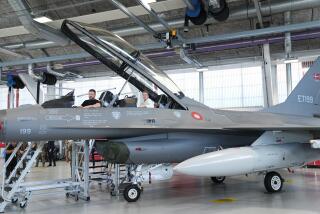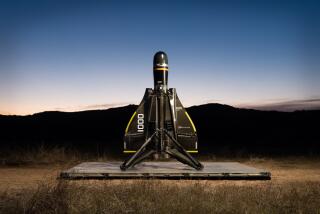Northrop, Lockheed Picked to Develop 21st-Century Jets : Thousands of Jobs Seen for L.A. Area
Two Los Angeles area companies--Northrop and Lockheed--were chosen today to design and build prototypes of a high-tech advanced tactical fighter that is to provide the heart of the nation’s airborne arsenal through the middle of the 21st Century.
Those prototypes will be pitted against each other in a fly-off competition in the 1990s, with the winner getting a lucrative production contract for 750 of the planes worth between $40 billion and $50 billion.
Northrop will head a team that includes McDonnell Douglas. Lockheed will head a team that includes Boeing and General Dynamics.
The winning contractors will provide thousands of jobs for their local economies for more than a decade.
General Dynamics Chosen
At the same time, the Air Force opted today for a modified version of General Dynamics’ F-16 for a $4-billion purchase of 270 air-defense fighters to protect the continental United States from attack.
The decision to use the F-16 was a blow to Los Angeles-based Northrop Corp.
It was widely believed that Northrop, which has spent $1 billion of its own money developing the F-20 since 1982, would scrap the plane if it lost the competition. Northrop had been unable to persuade anyone, even foreign nations, to buy the plane, ostensibly because it lacked the Pentagon’s imprimatur.
The contract for the advanced tactical fighter, or ATF, is one of the biggest and most important Pentagon contracts on the horizon.
Northrop has facilities in Hawthorne, El Segundo, Pico Rivera, Newbury Park, Anaheim and Palmdale. If Northrop became prime contractor for an advanced fighter, it is expected that engineering and initial production work would be done in Hawthorne, primary assembly in El Segundo and final production and flight testing in Palmdale.
Southland Jobs
If Calabasas-based Lockheed were to become the prime contractor on the advanced fighter, it is expected that some research work would be done in its Newhall-Saugus area research facility, some engineering, fabrication and general assembly work would be done in Burbank, and final assembly and flight testing would be done in Palmdale. Some fabrication work might also be done in Watts.
Only vague details of what the ATF would be like have been provided previously. The Air Force has said only that the plane would be capable of prolonged supersonic flight and have the latest radar-evading technology, plus other unspecified high-technology capabilities.
“We are not talking about an incremental increase over what exists now,’ said one aerospace official who requested anonymity. “We are talking about a quantum leap.”
Some observers have termed the ATF “a Luke Skywalker-type jet,” referring to the space fighter flown by the hero of the “Star Wars” movies.
Pooling of Resources
Because of the impact of the contract on the economies of the winning and losing companies, the Air Force urged defense contractors to bid as teams so they could pool resources and spread the economic benefits.
Two teams were formed: one by Northrop and St. Louis-based McDonnell Douglas Corp., and the other by Lockheed, Boeing Co. of Seattle and General Dynamics Corp. of St. Louis.
Individual bids were submitted by Grumman Corp. of Bethpage, N.Y., and Rockwell International Corp. of Pittsburgh, Pa.
More to Read
Inside the business of entertainment
The Wide Shot brings you news, analysis and insights on everything from streaming wars to production — and what it all means for the future.
You may occasionally receive promotional content from the Los Angeles Times.










